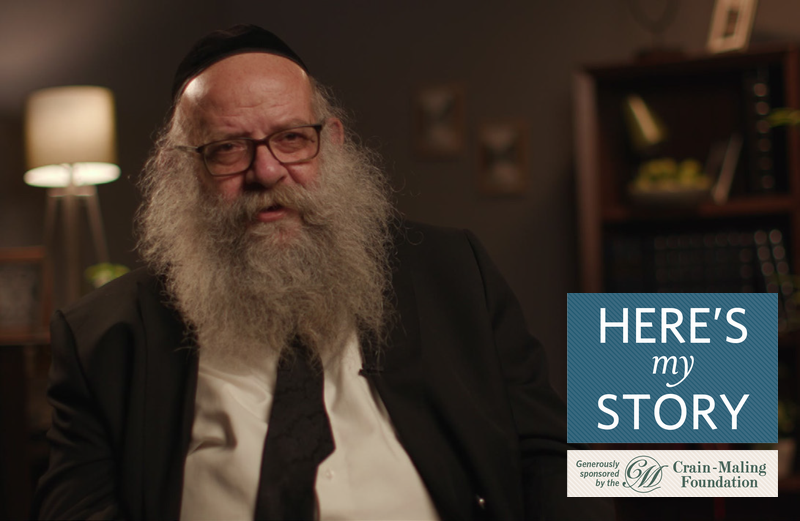
Here’s My Story: Vandalism Changes Everything
Rabbi Mordechai Stern
Click here for a PDF version of this edition of Here’s My Story, or visit the My Encounter Blog.
In 1979, a couple of years after my wife and I got married, the Rebbe directed us to move to Jerusalem, where I was born, and where my parents still lived. He encouraged me to join my father’s accounting business, and a few months later I also began teaching chasidic thought in Toras Emes yeshivah, in the Chabad neighborhood of Jerusalem. The next year, we moved to the neighborhood of Givat Shaul.
In 1985 we found that there was an old synagogue in the area that hadn’t seen a minyan for some three years and was now empty and locked. Together with some other young men in the area, we reopened the synagogue. We got the keys, cleaned it up, brought a Torah scroll and started regular services. Eventually it became “Merkaz Shneor,” the local Chabad synagogue for Givat Shaul and nearby Har Nof.
The Rebbe encouraged us quite a lot when I reported on all of this, and quite presciently: Almost as soon as we started, some thirty families moved into the neighborhood. Most had come from English-speaking countries and found themselves lost in Jerusalem. With classes and speeches offered in English as well as Hebrew, our synagogue was a lifesaver for them, and so our community grew.
The following summer, a local volunteer came to the synagogue together with his son. It was a Thursday afternoon and they were going to set up for Shabbat, but to their surprise, the door was wide open. Inside, they found a scene of destruction: Holy books thrown all over, the curtain of the Ark ripped, and a torn Torah scroll lying on the floor.
As we later learned from the police investigation, a young Arab man had broken in, apparently looking for money. Once he didn’t find any in the charity boxes, however, he decided to destroy whatever he could. He broke into the Ark, removed the Torah scroll and cut it with a knife.
The volunteer called me right away, and I called the authorities. The police came immediately, as did Mayor Teddy Kollek, and after him the city’s chief rabbi, Rabbi Yitzchak Kulitz. They wanted to see the disaster for themselves. All were shocked by what they saw.
“Don’t worry about the Torah scroll,” Mayor Kollek told me. “You find a new one, and I’ll pay for it.”
Once we finished with the police, I went home, called the Rebbe’s secretaries and told them what had happened. The Rebbe was on his way to pray at the resting place of the Previous Rebbe and he only received the message when he returned late that night.
By then it was 5:00 AM in Israel, which was when I got a call from one of the secretaries with a list of instructions, which I immediately wrote down.
First, on the day of the traditional burial service held for the sections of the Torah scroll that had been damaged, in addition to rewriting the destroyed columns, we were to start writing a new scroll in the synagogue. If the scribe could begin writing the scroll “right next to the Ark, all the better.”
Second, for at least the next thirty days, during school hours, a group of children should be brought into the synagogue, to study Torah there.
Third, although we had only held weekday services twice a week, the Rebbe now asked us to start having a minyan at least once a day, until after the upcoming Tishrei holidays.
Fourth, we should acquire more holy books, “a greater number than the books lost in the incident.”
Fifth and sixth were to bring in more charity boxes, as well as to found a new charitable free-loan society in the synagogue. “And ideally,” he wrote, “the first loan should be given that very day.” We first assumed that this meant the day of the Torah’s funeral, but then someone suggested that it meant the day we received this message. We immediately got someone to give a donation, and then someone else took out a loan, and so about five minutes before Shabbat, I was able to call the Rebbe’s office and let them know that we did this.
Seventh, for Shabbat the next day, the Rebbe asked for representatives from other synagogues in Jerusalem to join us for services. Eighth and ninth, he called for there to be extra Torah classes that Shabbat, and more chasidic teachings delivered at the third meal at the end of the day.
The tenth and last instruction was interesting. “I hope – based on the teaching of our Sages that ‘one who works hard will succeed’ – that you will find someone who is celebrating a brit on this Shabbat, and convince him to have it in the synagogue, with the synagogue participating in the expenses of the feast.”
Additionally, the Rebbe pointed out that the damaged Torah scroll should be handled in accordance with Jewish law and Jerusalem custom, and that we should consult the local rabbis in this regard.
He also offered to pay for any outstanding expenses we would incur. Later that year, however, when I was in New York, I told him that my family had covered all the expenses ourselves, to which he responded with his blessings.
He concluded the message with a prayer that G-d “fill the breaches” of Jerusalem, and “may our eyes soon behold Your return to Zion.”
In an address on that first Shabbat, the Rebbe spoke of “something negative that occurred at a synagogue,” even though most people in New York didn’t even know what he was referring to. He added that steps had already been taken, in the “three areas of Torah, prayer, and charity, to remedy the matter.”
The chief Sephardic rabbi of Israel, Rabbi Mordechai Eliyahu, who lived about ten minutes away, joined us for the services on Friday night, as well as on Shabbat morning, when he gave a big speech. Others came to join us from all over Israel. At the funeral, there were over ten thousand people, including Israel’s two chief rabbis, Rabbi Avraham Shapiro and Rabbi Mordechai Eliyahu, the chief rabbis of Jerusalem, Rabbi Yitzchak Kulitz and Rabbi Shalom Mashash, along with members of Knesset and the future Rebbe of Ger, Rabbi Pinchas Menachem Alter.
When it was all finished, I faxed a report to the Rebbe, and half an hour later, I got a call. “The Rebbe received your report,” the secretary told me, “and now he wants there to be an elevation in the synagogue – spiritually and physically.”
“Spiritually I understand, but what does a physical elevation mean?” I asked.
He checked, and the Rebbe clarified that he was referring to any renovations the synagogue might need. So we managed to create a new women’s gallery by knocking down a wall in the synagogue. We introduced Torah classes for every night of the week and an adult study program for English speakers. The synagogue became a source of Torah learning for every kind of Jerusalemite: Not just for Chabad, but for people from other chasidic and non-chasidic backgrounds, for the religious as well as the non-religious.
The Rebbe’s point was that immediately after this destruction, we needed to do something constructive; the descent should result in an ascent, as the chasidic expression goes. And indeed, our community has grown tremendously over the years, and it continues to do so today.
Formerly a teacher and community rabbi in Jerusalem, Rabbi Mordechai Stern now resides in Crown Heights. In the summers he leads Congregation Beis Menachem in Tannersville, New York. He was interviewed in May 2021.















Tannersville Resident
Rabbi Stern Sheychya
As A True Tzadik,